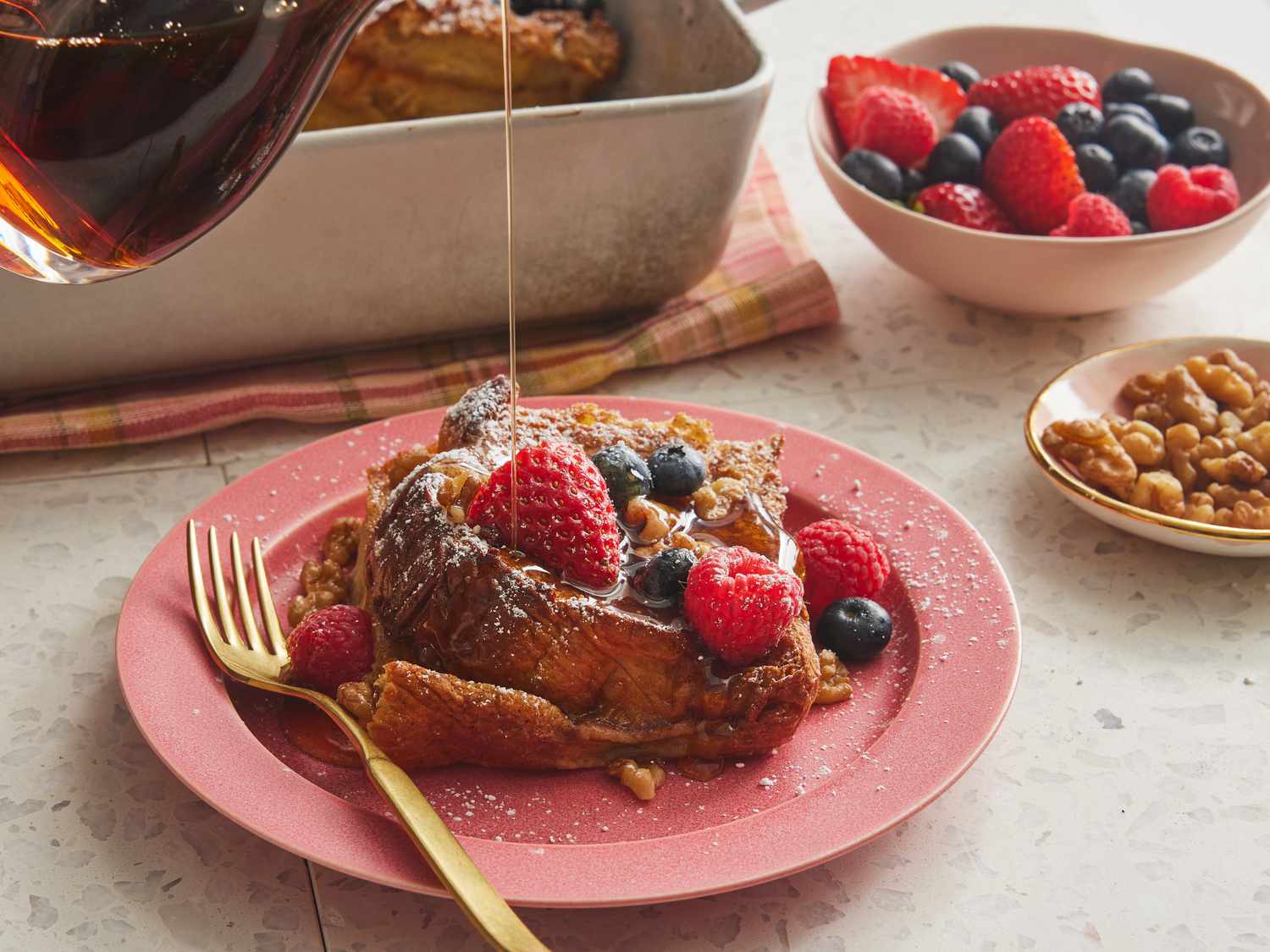
Why It Works
- Oven-drying the bread dehydrates it and helps it hold its shape in the casserole.
- Dunking toasted bread into the custard ensures that the egg mixture is evenly distributed throughout the dish.
- Brushing the cooked casserole with butter and topping it with cinnamon sugar before broiling produces a sweet and slightly crunchy crust.
Professional cooks hate working brunch service. I don’t blame them—I personally would not want to be churning out eggs, bacon, and pancakes for a ravenous, hungover crowd on a Saturday or Sunday morning. (As Anthony Bourdain famously wrote in his book Kitchen Confidential, “brunch is demoralizing to the serious line cook.”)
Making brunch in the comfort of my home, however, is an entirely different scenario. I actually like feeding ravenous people—especially if they’re the ones I love. Still, you will not find me making eggs to order, nor will you find me flipping pancakes one by one. Instead when it’s time to sit down to eat, you’ll find an already clean kitchen and a table set with a baked French toast casserole just fresh out of the oven, served alongside bowls of fresh berries, toasted nuts, and a jug of dark amber maple syrup.
Serious Eats / Fred Hardy
That’s the beauty of a baked French toast casserole: You can soak the bread in the custard the night before, and in the morning, all that’s left to do is pop it in the oven. The spot-on baked French toast recipe we’re sharing here comes from our Birmingham, Alabama-based test kitchen colleague Elizabeth Mervosh, who baked batches and batches of the casserole to land on a recipe for a tender, custardy casserole you can make ahead. Read on for her recipe, along with tips on how to make the very best baked French toast casserole.
The Best Bread for Baked French Toast Casserole
As our editorial director Daniel touched on in his quick-and-easy French toast recipe, French toast tastes best not when it’s made with stale bread but rather when it’s made with oven-dried bread: “There’s something about oven drying that dehydrates the bread while preserving its fresh taste. Plus, it tends to deliver the best textures: super crisp and toasty on the outside, yielding (but not mushy) within.” Here, we take a page out of his book by oven drying the bread in a 250ºF (121ºC) oven and flipping it halfway through, which guarantees that each slice crisps evenly. We recommend using brioche or challah, which are firm but tender enough to absorb the custard without disintegrating. Avoid crusty loaves, which take much longer to hydrate and soften.
Don’t Shy Away From the Vanilla and Spices
Vanilla extract, ground nutmeg, and cinnamon give this baked French toast casserole a subtly sweet and warm spiced note. While that blend is delicious, you can also play around with different spices and mix-ins to switch up the flavor profile. Add a touch of orange zest for brightness, or give the casserole autumnal flair by incorporating half a teaspoon of pumpkin pie spice. You could even swirl apple butter or jam into the custard if you want something more fruit-forward, or swap out the granulated sugar for light or dark brown sugar, which will bring a pleasant molasses note to the casserole.
Dunk Your Bread in the Custard—Then Let It Sit
Many baked French toast casserole recipes have you pour custard over slices of bread in a baking dish, but with that method, we noticed that the custard didn’t always absorb evenly into the bread. The much more consistent method? Dunking the toasted bread into the custard mixture—just as you would for regular French toast—which guarantees that every inch of the bread was soaked. After you dip the bread, you’ll lay it out in the baking dish, then pour the remaining egg mixture over the sliced bread and let it sit in the fridge until well soaked, about an hour and a half. You can bake it immediately after that soak, but if you want to make it ahead, you can let it sit in the fridge for up to 12 hours before baking it.
Top With Melted Butter and Cinnamon Sugar
Because the oven dries out the surface of the casserole as it bakes, we decided to offset some of that dryness by brushing the cooked casserole with melted butter. We then top the baked casserole with fragrant cinnamon sugar and broil it for several minutes, which produces a sweet and pleasantly crunchy crust that contrasts nicely with the tender, custardy casserole.
This recipe was developed by Elizabeth Mervosh; the headnote was written by Genevieve Yam.
Trending Products










